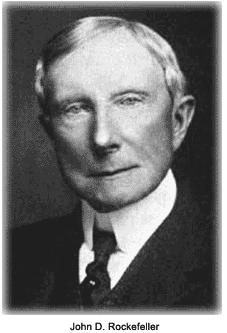John D. Rockefeller: The Ultimate Oil Man
John Davison Rockefeller was born the second of six children to a working class family in Richford, New York, a small community between Ithaca and Binghamton. In 1853, his family moved to a farm in Strongsville, Ohio, near Cleveland. He pursued a Public Education, but left high school to take business training.
In 1855, Rockefeller found his first job, working as an assistant bookkeeper for less than four dollars a week. He showed a talent for detail and a strong work ethic from the beginning. In 1859, Rockefeller's diligence was rewarded by being made a partner.
In that same year, oil was discovered in not-too-distant Titusville, Pennsylvania, touching off the growth of a new industry driven largely by the demand for kerosene for lighting. Rockefeller was immediately attracted to the oil business, but was repelled by the disorder of the wildcatters.
He finally made his bid in 1863, by creating a refining business with Maurice B. Clark and other partners. Cleveland, with its Great Lakes access, rail service and supply of immigrant labor, emerged early as a refining center. In 1870, Rockefeller teamed with his brother William, Henry M. Flagler, and Samuel Andrews (inventor of an inexpensive means of refining crude oil) to establish the Standard Oil Company.
 Standard Oil and its subsidiaries quickly managed to consolidate the refining business in the Cleveland area and then began to extend their control into Pittsburgh, Philadelphia and New York City. Beginning in the 1870s, Standard Oil employed a number of cutthroat business practices, including:
Standard Oil and its subsidiaries quickly managed to consolidate the refining business in the Cleveland area and then began to extend their control into Pittsburgh, Philadelphia and New York City. Beginning in the 1870s, Standard Oil employed a number of cutthroat business practices, including:
- Monopolization — Rockefeller is remembered for buying up all of the components needed for the manufacture of oil barrels in order to prohibit his competitors from getting their product on the market
- Rate Wars — the giant Standard Oil was able to withstand short term losses by cutting the price of oil; smaller competitors could not keep pace and either went out of business or sold out to Rockefeller
- Rebates — Rockefeller was able to demand a refund on public rates offered by the railroads; the carriers agreed to this practice because of Standard's immense volume
- Intimidation — on more than one occasion Standard dispatched thugs to break up competitors' operations that could not otherwise be controlled
Standard Oil originally followed the path of
horizontal integration, but later in its history it turned toward
vertical integration.
In 1882, the
Standard Oil Trust was formed, first of the great corporate
trusts. However, 10 years later an Ohio Supreme Court decision forced dissolution, resulting in the creation of 20 smaller businesses. The largest segment was reorganized in 1899 as a
Holding Company under the name of the Standard Oil Company of
New Jersey, but was dissolved following a
U.S. Supreme Court decision in 1911. Rockefeller retired at this point.
Rockefeller had followed other business interests besides oil, especially toward the end of his tenure. He dabbled in banks, railroads, timber, iron fields, and was a director of U.S. Steel. He accumulated assets in the range of $1 billion.
To many observers, Rockefeller appeared to be a man of glaring contradictions. He eagerly crushed his competitors, ruining hundreds in his pursuit of profit. Yet he was a deeply religious man; he became a Baptist, was active in church affairs for many years and was a generous financial supporter throughout. Rockefeller reduced his workload at Standard Oil in the 1890s to direct some of his energies toward philanthropy; after his retirement, he devoted his remaining 26 years to that endeavor. Major Rockefeller charitable ventures included:
- Rockefeller Institute for Medical Research. In 1901, Rockefeller created an organization to study the cause and prevention of disease. The Institute later became Rockefeller University.
- General Education Board. Created in 1902, the GEB supported a wide variety of educational improvements, concentrating attention on medical schools and the improvement of public education in the South. Before it was phased out in 1965, the GEB distributed more than $300 million.
- Rockefeller Sanitary Commission. Established in 1909 to address the problem of hookworm disease, the Commission mounted massive educational campaigns in the South. Later, efforts were launched overseas before the organization was closed in 1915.
- The Rockefeller Foundation. Given the broad charge "to promote the well-being of mankind throughout the world," the Foundation provided funding for public health, medical schools, famine prevention, the social sciences, the arts and many other endeavors. Begun in 1913, the Foundation continued and expanded the activities of the Sanitary Commission, and remains one of the world's leading philanthropic forces today.
- University of Chicago. Rockefeller instituted the challenge grant approach to establish what was initially a Baptist institution of higher learning. He offered to make a large donation if a similar amount could be raised from other sources within a certain time frame; he favored this approach because it demonstrated a base of support for a project and he would turn to this form of philanthropy many times over the years. Rockefeller was also a generous benefactor of Columbia, Harvard, Spelman, Bryn Mawr and Yale.
 Standard Oil and its subsidiaries quickly managed to consolidate the refining business in the Cleveland area and then began to extend their control into Pittsburgh, Philadelphia and New York City. Beginning in the 1870s, Standard Oil employed a number of cutthroat business practices, including:
Standard Oil and its subsidiaries quickly managed to consolidate the refining business in the Cleveland area and then began to extend their control into Pittsburgh, Philadelphia and New York City. Beginning in the 1870s, Standard Oil employed a number of cutthroat business practices, including: